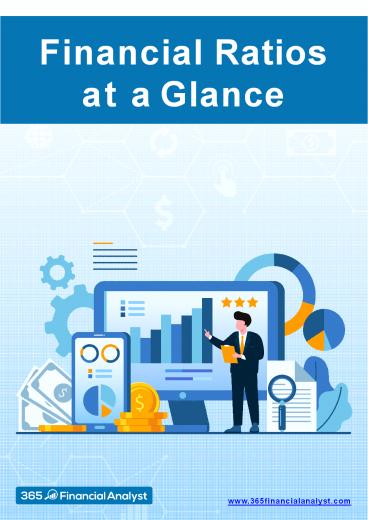Financial Ratios at a Glance - PowerPoint PPT Presentation
Title:
Financial Ratios at a Glance
Description:
A set of Ratio-related formulas that can be useful for financial professionals – PowerPoint PPT presentation
Number of Views:11
Title: Financial Ratios at a Glance
1
Financial Ratios at a Glance
www.365financialanalyst.com
2
ACTIVITY RATIOS
Meaning
The efficiency of a company in collecting its
trade receivables
Receivables turnover Annual sales
Average receivables
The average number of days a company takes to
collect its receivables from clients
Days of sales outstanding 365
Receivables turnover
Cost of goods sold Average inventory
The efficiency of a company in terms of
inventory management
Inventory turnover
365 Inventory turnover
The average inventory processing period
Days of inventory on hand
The efficiency of a company in allowing trade
credit to suppliers
Payables turnover Purchases
Average trade payables
The average number of days a company takes to
pay its suppliers
Number of days of payables 365
Payables turnover ratio
The efficiency of a firm in utilizing its fixed
assets
Fixed assets turnover Revenue
Average net fixed assets
The efficiency of a firm in managing its working
capital (current assets - current liabilities)
Working capital turnover Revenue
Average working capital
The efficiency of a firm in using its total
assets to create revenue
Total assets turnover Revenue
Average total assets
Days of sales outstanding Cash conversion cycle
Days of inventory on hand - Number of days of
payables
The number of days a company takes to convert
its investments in inventory and other resources
into cash flows from sales
The efficiency of a firm in utilizing equity to
create revenue
Equity turnover Revenue
Average total equity
3
LIQUIDITY RATIOS
Meaning
Current ratio Current assets
Ability to meet current liabilities (with total
current assets)
Current liabilities
Quick ratio Cash Marketable securities
Receivables
Ability to meet current liabilities (with total
current assets, excluding inventory)
Current liabilities
Cash ratio Cash Marketable securities
Ability to meet current liabilities (with cash
and marketable securities only)
Current liabilities
The number of days a company can cover its
average daily expenses with the use of current
liquid assets only
Defensive Cash Marketable securities
Receivables
interval
Average daily expenditure
4
SOLVENCY RATIOS
Meaning
Debt as a percentage of total equity
Debt-to-equity Total debt
Total shareholders equity
Debt as a percentage of total capital
Debt-to-capital Total debt
Total debt Total shareholders equity
Debt as a percentage of total assets
Debt-to-assets Total debt
Total assets
An indicator of a companys debt financing usage
Financial leverage Average total assets
Average total equity
Earnings before interest and taxes Interest
payments
The ability to cover interest expenses
Interest coverage
Fixed charge Earnings before interest and taxes
Lease payments
The ability to cover interest and lease expenses
coverage
Interest payments Lease payments
5
PROFITABILITY RATIOS
Meaning
Gross profitability as a percentage of total
revenue
Gross profit margin Gross profit
Revenue
Operating income (EBIT) Operating profit margin
Operating profitability (before interest and tax)
as a percentage of total revenue
Revenue
Operating profitability (before tax) as a
percentage of total revenue
Pre-tax margin EBT
Revenue
Net profitability as a percentage of total revenue
Net profit margin Net income
Revenue
Net income Average total assets
Net profitability (excluding interest and taxes)
as a percentage of total invested funds
Return on assets (ROA)
Net profitability (including interest and taxes)
as a percentage of total invested funds
Operating return on assets (ROA) Operating
profit (EBIT)
Average total assets
Operating profitability as a percentage of total
capital
Return on total capital Operating profit (EBIT)
Average total capital
Net profitability as a percentage of total equity
Return on Equity (RoE) Net income
Average equity
6
VALUATION RATIOS
Meaning
Earnings per Share (EPS) Net Income - Preferred
dividends
Income earned per 1 common share outstanding
Outstanding number of common shares
The price that investors are willing to pay per
1 of earnings
Price earnings (P/E) ratio Share price
Earnings per share (EPS)
Total price that investors are willing to pay for
a company's Net income
P/E ratio (company wide) Market capitalization
Net income
Dividend yield Dividend per share
The "portion "of a share price that is
distributed as dividends
Current share price
Net income - Dividends declared Net income
The "portion" of Net income that is reinvested in
the company
Retention rate (RR)
The "portion" of Net income that is distributed
as dividends
Dividend payout Dividends declared
Net income
Equity growth rate
Sustainable growth rate (g) RR x ROE
7
DUPONT ANALYSIS
Return on Equity (RoE) Net income Average equity
Net profit margin Net income Revenue
Equity turnover Revenue Average equity
X
Net profit margin Net income Revenue
Asset turnover Revenue Average assets
Financial leverage ratio Average assets Average
equity
X
X
Interest burden EBT EBIT
Asset turnover Revenue Average assets
Financial leverage ratio Average assets
Average equity
Operating profit margin EBIT Revenue
Tax burden
X
X
X
X
Net income EBT
8
www.365financialanalyst.com































